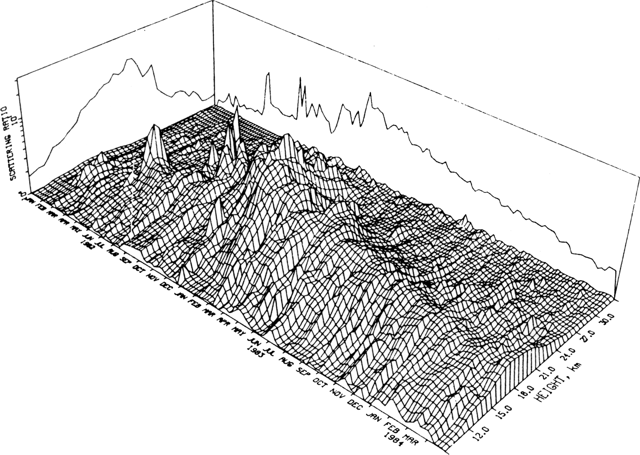Report on Atmospheric Effects (1980-1989) — September 1984

Atmospheric Effects (1980-1989)
Scientific Event Alert Network Bulletin, vol. 9, no. 9 (September 1984)
Managing Editor: Lindsay McClelland.
Atmospheric Effects (1980-1989) Two years of lidar data from Germany summarized
Please cite this report as:
Global Volcanism Program, 1984. Report on Atmospheric Effects (1980-1989) (McClelland, L., ed.). Scientific Event Alert Network Bulletin, 9:9. Smithsonian Institution.
Atmospheric Effects (1980-1989)
All times are local (unless otherwise noted)
Lidar and balloon data showed that aerosols from the March-April 1982 eruption of El Chichón remain in the stratosphere. Despite the 15-km eruption clouds reported during the Mayon eruption, no new aerosol layers were detected. At Mauna Loa, Hawaii, integrated backscattering values were lower in September than in August. Cirrus clouds were abundant throughout the month, masking any upper tropospheric aerosols that might have been present. A sunrise during clear weather in early October did not show any apparent aerosol layers. At Hampton, Virginia, a very broad backscattering peak and somewhat increased integrated backscatter were measured 6 September, but a profile with a narrower peak on 19 September (the last measurement of the month) yielded integrated values lower than in August. September values from Fukuoka, Japan were similar to those from the last measurement in mid-July. April-June lidar data from Garmisch-Partenkirchen, Germany show a gradual decrease in backscattering from stratospheric aerosols. A 3-dimensional representation of the structure of the aerosol profile since early 1982 is shown in figure 8. Balloon data from Laramie, Wyoming have continued to show slow decay of the El Chichón aerosols. No material from Mayon was evident during a flight 6 October.
Information Contacts: R. Reiter, Garmisch-Partenkirchen, W. Germany; T. DeFoor, MLO; M. Osborn, NASA; M. Fujiwara and M. Hirono, Kyushu Univ., Japan; J. Rosen, Univ. of Wyoming.

